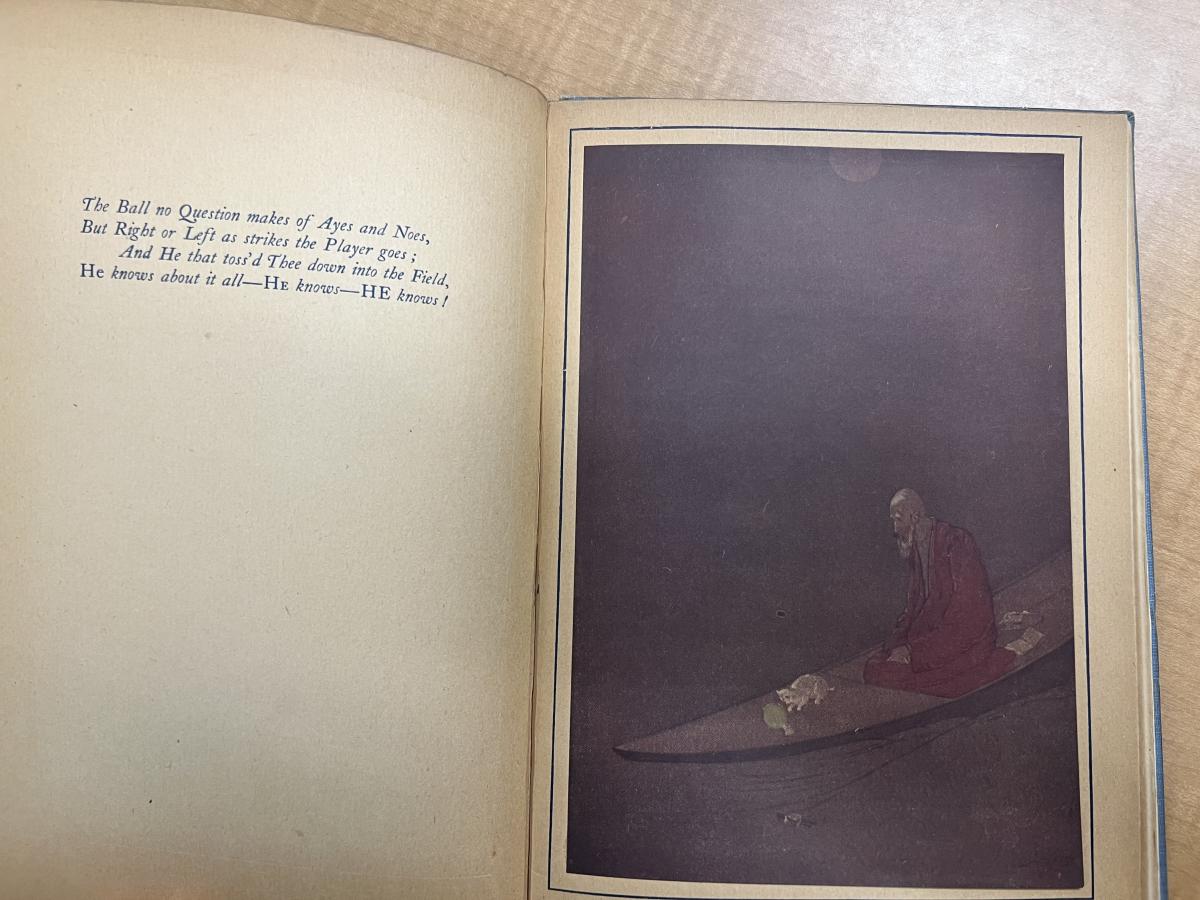Though Quatrain L explores the philosophical questions of a higher power and predeterminism, Abanindro Nath Tagore’s accompanying illustration in The Rubáiyát of Omar Khayyám, The Astronomer Poet of Persia physicalizes the intangible, creating a visual metaphor which both complicates, extends and undermines Fitzgerald’s translation of the text.
Quatrain L likens life to a game void of value judgements: “The Ball no Question makes of Ayes and Noes” (Khayyám). The quatrain goes on to explain that it is the player’s – the individual’s – ability to change the course of the ball, questioning the idea of predeterminism: “But Right or Left as strikes the Player goes” (Khayyám). The second half of the quatrain introduces a “He” and repeatedly declares “He knows,” implying an omniscient entity that is conscious of the game of life.
The accompanying illustration to this quatrain depicts an older man in a red robe watching a cat play with a ball while on what looks like a wooden platform (see Figure 1). The man looks down on the cat and ball, implicitly inhabiting a higher cognition (godlike). His white beard connotes the wisdom that comes with time and age. Seen next to him is a pair of shoes and an open book. One could argue that this man has read Khayyám’s words, gained a consciousness above the everyday person, taken off his shoes to subscribe to Khayyám’s life philosophy of leisure and now watches as the cat plays with the Ball of Life. Though it’s difficult to discern if Tagore’s painting is a likeness of a god or just a man that has opened his mind to Khayyám’s teachings.
In addition, the cat further complicates Khayyám’s quatrain, because the ball is at the mercy of a conscious being subordinate to human cognition – the cat. Does this mean that the cat will never be able to reach the enlightenment of Khayyám’s words – since it cannot sit and read the text itself – or is the cat just there to represent the narrow-mindedness of those who play the game of life without really understanding their power of autonomy? The cat’s eyes are transfixed on the ball; it’s the cat’s whole world, it’s all that it sees. The man, though, has a higher vantage point, and is able to look around at the infinite sea of thought beyond him.
The one constant between the quatrain and the illustration is the ball, possibly because Tagore could not think of how else to physicalize the idea of life as a game and the “Ball” (Khayyám ). As the “Player” is depicted as the cat and “He” as the man, when taking in the illustration alone, Khayyám’s philosophical deep-dive isn’t conveyed, and a reduction of the narrative occurs. Meaning, the illustration alone tells the audience nothing about Khayyám’s perspective. But, when paired with Quatrain L, the illustration isn’t wholly consistent with the text, which also muddies the waters and makes it difficult to understand Khayyám’s point, as the visual metaphor deviates from the original message.
Works Cited:
Khayyám Omar. The rubáiyát of Omar Khayyám Fitzgerald's Version with Twelve Illustrations by Abanindro Nath Tagore. Translated by Edward Fitzgerald, George W. Jacobs & Company, 19n.d..


